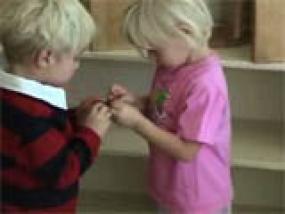Tying the Knot

Opportunities for enhancing and extending young children’s learning often arise during everyday activities. Children are naturally motivated to make sense of the challenges presented by real life problems. As educators, it is important to take risks and attempt to further such experiences by helping children generate their own questions, formulate and test their own hypotheses, and discover what information is necessary to solve a problem. Young children often surprise us with their tenacity for the subject at hand.
In this videative, Tucker’s necklace has come untied. Ayla wants to help her distressed friend so she offers to tie a knot in Tucker’s necklace. George, an educator visiting the classroom, works to identify the learning opportunities presented by this ordinary moment while also striving to respect the amount of adult assistance desired by the children. George encourages the children to question their belief that the necklace has been secured. His goal is not to point out what step in tying the knot Ayla has missed, but to encourage her to reflect on her thinking. When Ayla discovers she has not yet attained her goal, she asserts her role as caregiver and resumes fixing Tucker’s necklace. Ayla’s new theory is that more string through the purple bead makes a stronger knot. By describing the effect of her action, “So okay you’re getting a lot of string there,” George encourages Ayla to again reconsider the effectiveness of her solution. She tests her new knot by letting go and the purple bead slides down the string. As Ayla pushes the bead back up the string, she identifies the problem, “It’s so looser.” As if to invite George to talk about the problem with her, Ayla repeats, “It’s so looser.”
By studying the entire videative, we see how such an ordinary moment has the potential for a longer investigation of how children and teachers can foster relationships built upon “helping behaviors,” as well as the cognitive structures and fine motor skills necessary to solve problems such as tying small knots.
Keywords: Twos, String, Children-Object, Spatial Relations, Inside/Outside, Co-Construction, videative
Length of videative: 10 text pages, 10 video subclips
Length of stand-alone master video clip: 3 minutes, 28 seconds
